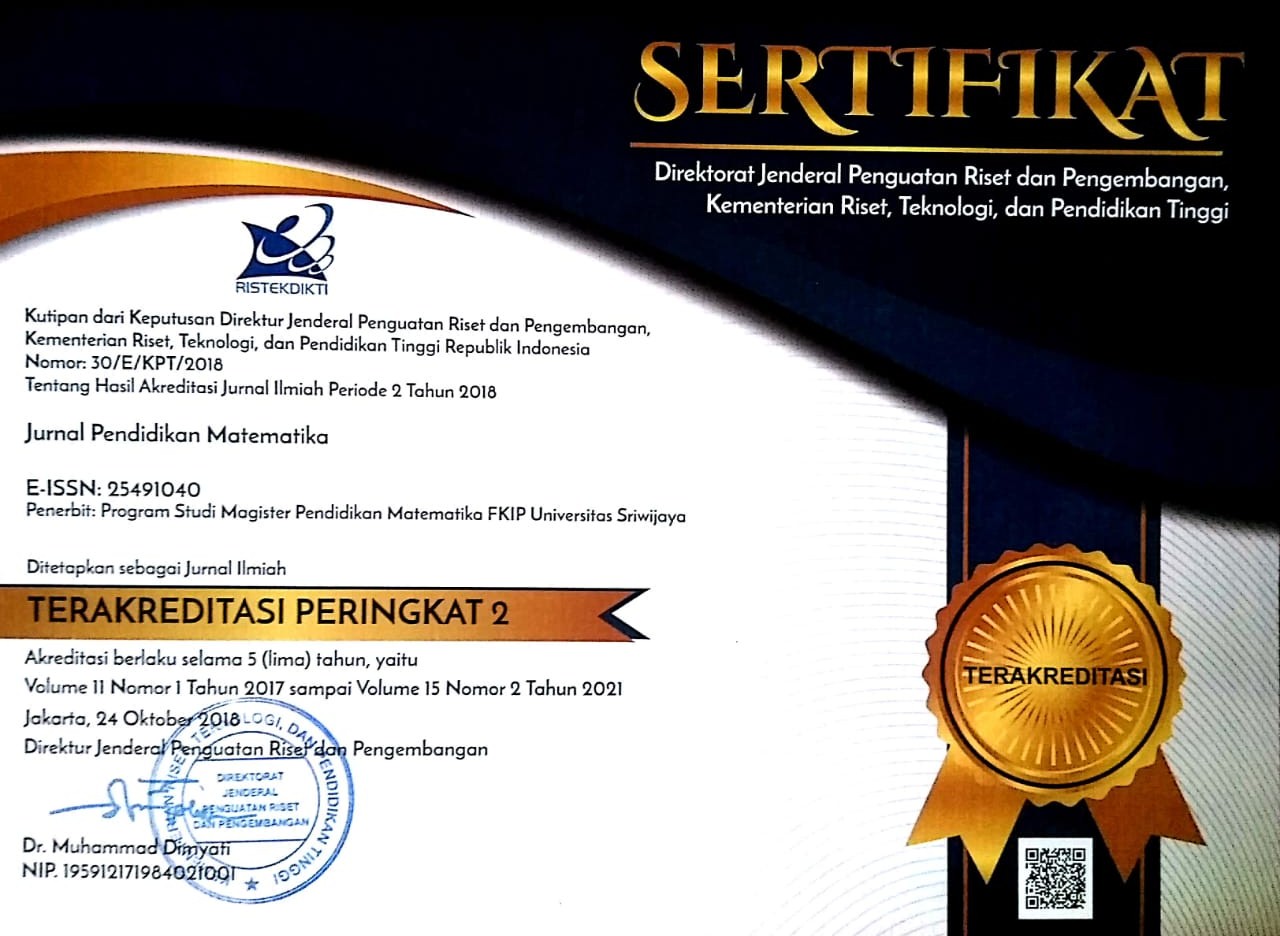Development of Social Arithmetic Teaching Materials Using IT-Based PMRI Approach for SMP Students
Abstract
This study aimed to develop teaching materials using an IT-based PMRI approach for junior high school students. The type of this research was a research and development model. This study employed the ADDIE development model consisting of five stages: analysis, design, development, implementation, and evaluation. The teaching materials were validated by material experts and media experts before being tested. In addition, this study involved a student response questionnaire investigating the IT-based teaching materials. The validity of teaching materials revealed an average score of 4.40 determined by the results of the teaching material assessment conducted by two expert lecturers, and an average score of 4.80, determined by the results of the teaching material assessment conducted by mathematics teachers at SMP Negeri 56 Palembang. The practicality of teaching materials (student books) had an average score of 4.27 determined by the students' responses to teaching materials. The results of validating material experts, media experts, subject teachers, and student response questionnaires indicated that the teaching materials developed were valid and practical. Overall, this study has shown that the teaching materials developed are very suitable for learning. In addition, the teaching materials developed can improve student learning outcomes on arithmetics materials.
Keywords
Full Text:
PDFReferences
Ahyansyah, Sa’dijah, C., & Qohar, A. (2020). Development of teaching materials based on indonesian realistic mathematics education (PMRI) to support problem solving ability of fraction count operations [in Bahasa]. Jurnal Pendidikan: Teori, Penelitian, dan Pengembangan, 5(12), 1827–1838. http://dx.doi.org/10.17977/jptpp.v5i12.14357.
Amadea, K., & Ayuningtyas, M. D. (2020). Comparison of the Effectiveness of Synchronous and Asynchronous Learning in Linear Program Materials [in Bahasa]. Primatika : Jurnal Pendidikan Matematika, 9(2), 111–120. https://doi.org/10.30872/primatika.v9i2.366
Ankamilah, A., Pranowo, H., & Permadi, A. (2013). Student Learning Outcomes through Realistic Mathematics Education Approaches on Social Arithmetic Materials [in Bahasa]. 330–336.
Anomeisa, A. B., & Ernaningsih, D. (2020). Interactive learning media using VBA PowerPoint in group data presentation [in Bahasa]. Jurnal Pendidikan Matematika Raflesia, 05(01), 17–31.
Dewi, N. P. R., Ardana, I. M., & Sariyasa, S. (2019). The effectiveness of geogebra assisted ICARE model to improve students’ mathematical problem solving ability [in Bahasa]. JNPM (Jurnal Nasional Pendidikan Matematika), 3(1), 109. https://doi.org/10.33603/jnpm.v3i1.1762
Hadi, S. (2017). Realistic mathematics education: Theory, development, and implementation (Revision) [in Bahasa]. RajaGrafindo.
Hikmah, S. N., & Maskar, S. (2020). Utilization of microsoft powerpoint applications in class VIII middle school students in cartesian coordinate learning [in Bahasa]. Jurnal Ilmiah Matematika Realistik, 1(1), 15–19. https://doi.org/10.33365/ji-mr.v1i1.215
Ibda, F. (2015). Cognitive development: Jean Piaget’s theory [in Bahasa]. Intelektualita, 3(1), 242904.
Idris, I., & Silalahi, D. K. (2016). Application of Realistic Mathematics Education (PMR) approach to improve story problem solving ability for class VII A SMP UTY [in Bahasa]. Jurnal EduMatSains, 1(1), 73–82. https://doi.org/10.33541/edumatsains.v1i1.71.
Jupri, A. (2018). The role of technology in mathematics learning with a realistic mathematics approach [in Bahasa]. Proceedings of The National Seminar Of Mathematics and Mathematics Education, 303–314. http://ejournal.radenintan.ac.id/index.php/pspm/article/view/2630
Kemdikbud. (2013). Curriculum 2013. Basic Competencies: High School (SMA)/Madrasah Aliyah (MA) [in Bahasa]. Kementerian Pendidikan dan Kebudayaan.
Lismareni, Somakim, & Kesumawati, N. (2019). Development of social arithmetic teaching materials using oil fuel context with Indonesian realistic mathematics education approach in SMP [in Bahasa]. Concept and Communication, null(23), 301–316. https://doi.org/10.15797/concom.2019..23.009
Mawardi, K., Dewi, E. S., Asmah, S., Pratiwi, T. N., Sari, U. I., Putra, F. G., & Widayanti, W. (2019). Developing islamic-nuanced linear algebra module with guided-inquiry approach in the matrix material. Journal of Physics: Conference Series, 1155(1). https://doi.org/10.1088/1742-6596/1155/1/012080
Misdalina, M., Zulkardi, Z., & Purwoko, P. (2013). Development of integral materials for senior high schools using the indonesian realistic mathematics education (PMRI) approach in Palembang[in Bahasa]. Jurnal Pendidikan Matematika, 3(1), 61–74. https://doi.org/10.22342/jpm.3.1.321.
Munir, M., & Sholehah, H. (2020). Indonesian Realistic Mathematics (PMRI) learning in improving problem solving ability [in Bahasa]. AJurnal Al-Muta’aliyah STAI Darul Kamal NW Kembang Kerang, 5(1), 33–42.
Nurhidayati, E. (2017). Constructivism pedagogy in Indonesian education practice [in Bahasa]. Indonesia Journal of Educational Counseling, 1(1), 1–14.
Putrawangsa, S., & Hasanah, U. (2018). Integration of digital technology in learning in the industrial age 4.0 [in Bahasa]. Jurnal Tatsqif, 16(1), 42–54. Https://doi.org/10.20414/jtq.v16i1.203
Raharjo, h. (2014). Development of computer-based teaching materials in mathematics learning on the subject of cubes and blocks. Education Mathematics, 2.
Rahmadani, H., Roza, Y., & Murni, A. (2018). Analysis of information technology-based mathematics teaching material needs at SMA IT Albayyinah Pekanbaru [in Bahasa]. Juring (Journal for Research in Mathematics Learning), 1(1), 91. https://doi.org/10.24014/juring.v1i1.5230
Riwayati, S., & Ridzky, K. (2020). Development of teaching materials triangle [in Bahasa]. Jurnal Math-UMB.edu, 7(2), 30–36. https://doi.org/10.36085/math-umb.edu.v7i2.462.
Rohim, A., & Asmana, A. T. (2018). Learning effectiveness in outdoor learning with PMRI approach on SPLDV materials [in Bahasa]. Jurnal Elektronik Pembelajaran Matematika, 5(3), 217–229. https://jurnal.uns.ac.id/jpm/article/download/26062/18276
Widoyoko, E. P. (2016). Authentic assessment in vocational learning to strengthen the competitiveness of vocational education graduates. Proceedings of The National Seminar on Automotive Engineering Education UMPurworejo, 1-14.
Widyastuti, N. S., & Pujiastuti, P. (2014). The influence of Indonesian Realistic Mathematics Education [in Bahasa]. Prima Edukasia, 2(2), 183–193. https://doi.org/10.21831/jpe.v2i2.2718.
DOI: https://doi.org/10.22342/jpm.15.2.13022.191-202
Jl. Srijaya Negara, Bukit Besar
Palembang - 30139 Indonesia
Jurnal Pendidikan Matematika is licensed under a Creative Commons Attribution-NonCommercial-ShareAlike 4.0 International License.
Indexed in:


